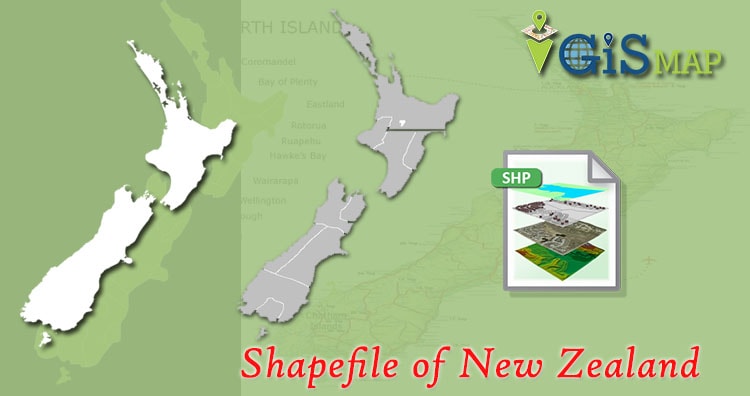Hello GIS enthusiasts, IGISMAP has now published the latest GIS vector data of New Zealand administrative levels. Links for downloading the shapefiles of the important administrative divisions of New Zealand are provided in the following. You can also download these data in KML, GeoJSON or CSV formats.
Note:
- All data available are in GCS datum EPSG:4326 WGS84 CRS (Coordinate Reference System).
- You need to login for downloading the shapefile.
- Most of following administrative GIS data are provided in both digital and cartographic extends
- Digital boundary – Polygon boundary data covering low level waterbodies
- Cartographic boundary – Polygon boundary data covering only land areas excluding all levels of waterbodies
Download Free Shapefile Data of New Zealand
New Zealand is an island country in the southwestern Pacific Ocean. It consists of two main landmasses—the North Island and the South Island and over 700 smaller islands. It is the sixth-largest island country by area, covering 268,021 square kilometers (103,500 sq mi). New Zealand is about 2,000 kilometers (1,200 mi) east of Australia across the Tasman Sea and 1,000 kilometers (600 mi) south of the islands of New Caledonia, Fiji, and Tonga. The country’s varied topography and sharp mountain peaks, including the Southern Alps, owe much to tectonic uplift and volcanic eruptions. New Zealand’s capital city is Wellington, and its most populous city is Auckland.
Download New Zealand National Boundary Shapefile
Download New Zealand National Cartographic Boundary Shapefile
Download New Zealand Regional Councils Shapefile Data
New Zealand is divided into 17 regions for local government purposes.
Download New Zealand Regional Council Boundaries Shapefile
Download New Zealand Regional Council Cartographic Boundaries Shapefile
Download New Zealand Territorial Authorities Shapefile Data
Territorial authorities are the second tier of local government in New Zealand, below regional councils. There are 67 territorial authorities: 13 city councils, 53 district councils and the Chatham Islands Council.
Download New Zealand Territorial Authority Boundaries Shapefile
Download New Zealand Territorial Authority Cartographic Boundaries Shapefile
Download New Zealand Wards Shapefile Data
Download New Zealand Ward Boundaries Shapefile
Download New Zealand Ward Cartographic Boundaries Shapefile
Other Administrative Shapefile Data:
- Download New Zealand Community Board Boundaries Shapefile
- Download New Zealand Community Board Cartographic Boundaries Shapefile
- Download New Zealand Subdivision Boundaries Shapefile
- Download New Zealand Subdivision Cartographic Boundaries Shapefile
- Download New Zealand District Health Board Boundaries Shapefile
- Download New Zealand Urban Rural Boundaries Shapefile
- Download New Zealand Urban Rural Cartographic Boundaries Shapefile
- Download New Zealand General Electorate Boundaries Shapefile
- Download New Zealand Constituency Boundaries Shapefile
- Download New Zealand Constituency Cartographic Boundaries Shapefile
Other GIS Data:
- Download New Zealand Highway Lines Shapefile
- Download New Zealand Railway Lines Shapefile
- Download New Zealand Airport Locations Shapefile
- Download New Zealand Ferry Terminal Locations Shapefile
Please note that the New Zealand data provided here is license under Open Data Commons Open Database License (ODbL). Please review the same before using it. If you want data under different license you can also look over to the post : Download Free Shapefile Maps – Country Boundary Polygon, Rail-Road, Water polyline etc
Download Free Shapefile for the following:
- World Countries Shapefile
- Australia
- Argentina
- Austria
- Belgium
- Brazil
- Canada
- Denmark
- Fiji
- Finland
- Germany
- Greece
- India
- Indonesia
- Ireland
- Italy
- Japan
- Kenya
- Lebanon
- Madagascar
- Malaysia
- Mexico
- Mongolia
- Netherlands
- New Zealand
- Nigeria
- Papua New Guinea
- Philippines
- Poland
- Russia
- Singapore
- South Africa
- South Korea
- Spain
- Switzerland
- Tunisia
- United Kingdom Shapefile
- United States of America
- Vietnam
- Croatia
- Chile
- Norway
Disclaimer : If you find any shapefile data of country provided is in correct do contact us or comment below, so that we will correct the same in our system.

